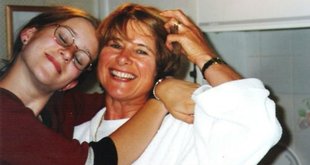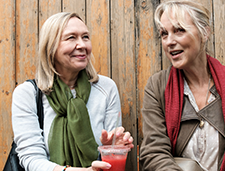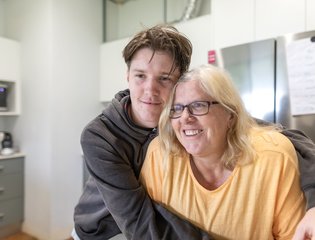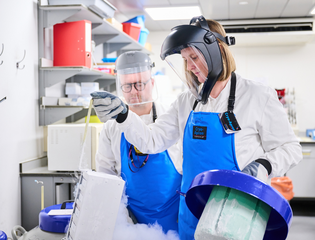Genetic testing
Jo Stanford lost her mother to ovarian cancer in 2006. Here she shares her experience, and the incredible impact genetic testing has had on her family.

Jo and her mother
Jo, how did ovarian cancer first impact your life?
I never really knew anything about ovarian cancer before 2003. It wasn't on my radar until my mum was diagnosed at the age of 53. Her diagnosis came after multiple visits to her GP with typical symptoms. Despite the challenges, she remained positive.
Were you aware of any family history of cancer?
It was my mum's GP who noticed a pattern. My grandmother had passed away from breast cancer at 41, and my mum's ovarian cancer diagnosis raised red flags. We were referred to a genetic counsellor and discovered a wide history of breast and ovarian cancer in our family tree so my mum decided to have the testing done.
What did the genetic testing reveal?
After my mum passed away in March, we received results showing she had a faulty BRCA1 gene. This explained the prevalence of cancer in our family and meant there was a 50/50 chance that her children inherited the gene fault.
Jo, who carries the faulty BRCA1 geneLosing mum was incredibly painful, but it also gave me the knowledge and power to take proactive steps to protect my own health and that of my family.
How did you feel about undergoing genetic testing yourself?
I initially went through genetic counselling at age 22 but decided against testing at that time. It wouldn’t change anything in my medical care at that age, and I didn't want to base my life decisions on the results.
What led you to finally get tested?
After having our first child, my husband and I were struggling without family support. Knowing I wanted to start risk-reducing surgeries in my early thirties if I had inherited the faulty gene, I decided to get tested so we could make decisions about having more children sooner rather than later. The results showed I did inherit the gene fault, giving me an 87% lifetime risk of breast cancer and up to 60% risk of ovarian cancer.
What steps did you take after learning about your genetic risk?
When I turned 30, I had a risk-reducing double mastectomy with reconstruction. This reduced my breast cancer risk from 87% to under 5%.
What about your ovarian cancer risk?
Unfortunately, there is no reliable screening for ovarian cancer. So, following recommendations I had my ovaries and fallopian tubes removed at 36. The earliest this is recommended varies depending on which gene fault you carry, but for BRCA1 that’s 35. This is because the surgery puts you into immediate menopause which carries long-term health risks.
Looking back on your experience Jo, how has your journey with your mum’s ovarian cancer and genetic testing shaped your perspective on life and health?
My mum’s ovarian cancer and the discovery of the BRCA1 gene fault have made a profound impact on my life. Losing her was incredibly painful, but it also gave me the knowledge and power to take proactive steps to protect my own health and that of my family. I deeply miss my mum and feel her absence in every milestone and daily moment, but I try to keep her memory alive and ensure my children know about the incredible woman she was. Her strength and love continue to inspire me every day, and I’m grateful for the ability to take control of my future, something she didn’t have the chance to do.


